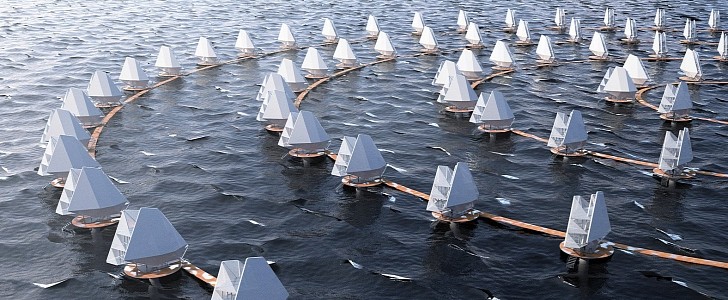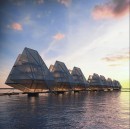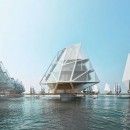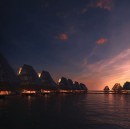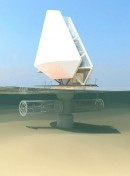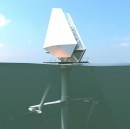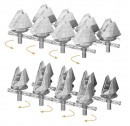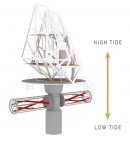In the context of climate change, natural calamities and rising sea levels, coastal communities are more or less stranded. Manila-based architecture firm Dada Design has an idea for a housing solution that would solve all these issues they’re facing – and bring about extra benefits.
As many other architects before them, the team at Dada Design believes the solution lies in embracing a life on the water by means of floating houses. Think something that is halfway between a house and a yacht, with the sole mention that, in the case of the Currents for Currents project, the houses can’t move from location to location.
They do, however, compensate for that by doubling as energy farms, harvesting it for other communities. So these floating houses aren’t just self-sufficient, durable and reliable in case of calamity, and extremely sophisticated-looking, but they can also furnish extra energy to other households. What is there not to love?
The Currents for Currents project isn’t a new one and it’s certainly not unique in suggesting people move to the water full-time. It stands out for proposing a community made of floating houses that are ideal for year-round living but that are also modular, which means they can be adapted to suit a variety of purposes, in a variety of scenarios.
“Coastal communities are caught in the cross fire between the scarcity of land and resources, and the rising tides and storm surges brought about by the sea,” the firm says. The idea is to use the tide and the storms to power these communities, and make the most of a bad situation.
These houses are anchored to the sea bed and built to withstand calamities. They can move to the sides and up and down, which means they won’t sink or come apart no matter what Mother Nature throws at them. In strong winds, they turn from side to side, following the path of least resistance. With the tide or in case of huge swells, they move up and down, and always remain above sea levels.
Tidal energy is harvested by means of an underwater turbine, while photovoltaic fabric covering the house stores solar energy. One such house has enough clean energy to be self-sufficient and can be turned into a part of an electricity farm, thus offering residents a constant income.
The houses within a community would be connected by bridges, and each unit would feature its very own hydroponic garden. This would presumably do away with feelings of isolation and contribute to that sustainable, self-sufficient way of life, respectively. The garden would be fed by recycled graywater.
Each floating house is modular, which, in conjunction with the fact that its main structural frame is made of molded plastic, which is universally available, makes it ideal for any coastal site around the world. Dada Design conceived this floating community with the Philippines in mind, but worked on the idea to make it universally applicable.
“With blue as the new green as the design philosophy, the Currents for Currents project can provide resilient, flexible living structures that can adapt to the sea’s ever-changing conditions,” Dada Design says. More importantly, it would offer a reliable housing solution in regions where infrastructure is lacking and conditions are less than favorable.
Dada Design never mentioned how much one such house could cost, and this is the big downside you probably guessed was coming. After all, if you plan to have developers build these communities for people with small incomes in calamity-stricken areas, pricing is perhaps the most important aspect to consider.
For the time being, the Currents for Currents project remains in concept stage. It’s been getting plenty of attention online as of late but, as far as we can tell, no serious investors. It’s still a very beautiful and bold dream for a possible future, isn’t it?
They do, however, compensate for that by doubling as energy farms, harvesting it for other communities. So these floating houses aren’t just self-sufficient, durable and reliable in case of calamity, and extremely sophisticated-looking, but they can also furnish extra energy to other households. What is there not to love?
The Currents for Currents project isn’t a new one and it’s certainly not unique in suggesting people move to the water full-time. It stands out for proposing a community made of floating houses that are ideal for year-round living but that are also modular, which means they can be adapted to suit a variety of purposes, in a variety of scenarios.
“Coastal communities are caught in the cross fire between the scarcity of land and resources, and the rising tides and storm surges brought about by the sea,” the firm says. The idea is to use the tide and the storms to power these communities, and make the most of a bad situation.
Tidal energy is harvested by means of an underwater turbine, while photovoltaic fabric covering the house stores solar energy. One such house has enough clean energy to be self-sufficient and can be turned into a part of an electricity farm, thus offering residents a constant income.
The houses within a community would be connected by bridges, and each unit would feature its very own hydroponic garden. This would presumably do away with feelings of isolation and contribute to that sustainable, self-sufficient way of life, respectively. The garden would be fed by recycled graywater.
Each floating house is modular, which, in conjunction with the fact that its main structural frame is made of molded plastic, which is universally available, makes it ideal for any coastal site around the world. Dada Design conceived this floating community with the Philippines in mind, but worked on the idea to make it universally applicable.
Dada Design never mentioned how much one such house could cost, and this is the big downside you probably guessed was coming. After all, if you plan to have developers build these communities for people with small incomes in calamity-stricken areas, pricing is perhaps the most important aspect to consider.
For the time being, the Currents for Currents project remains in concept stage. It’s been getting plenty of attention online as of late but, as far as we can tell, no serious investors. It’s still a very beautiful and bold dream for a possible future, isn’t it?
